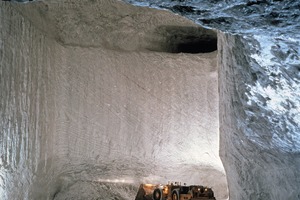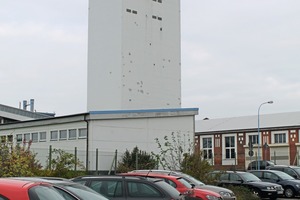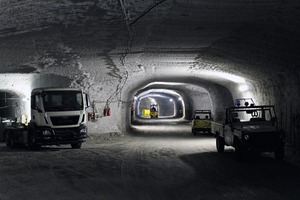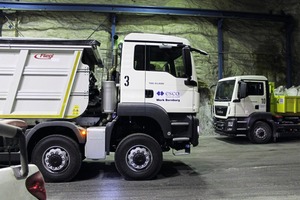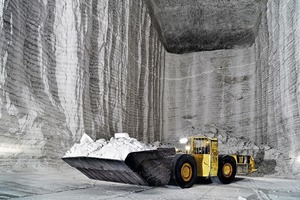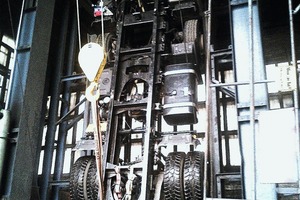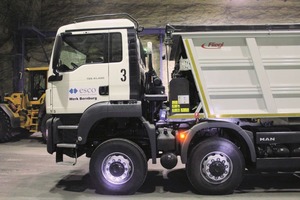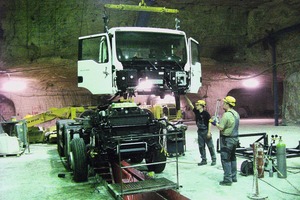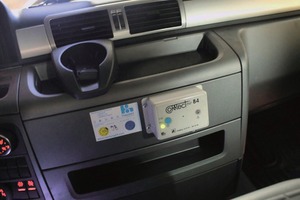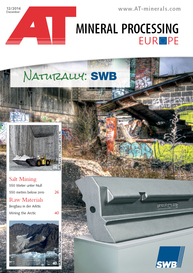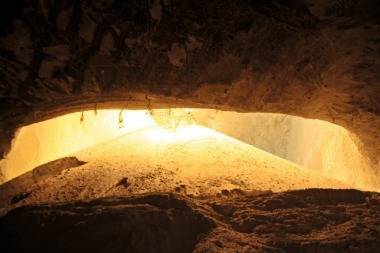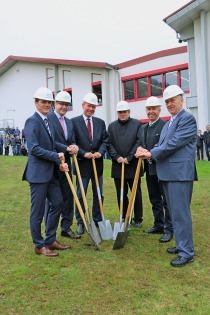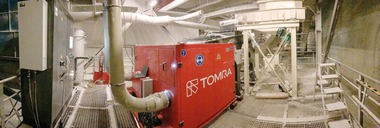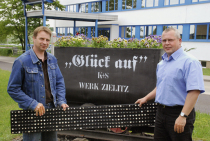550 metres below zero
Breathing air supply systems from the Hauser Umwelt-Service GmbH & Co. KG, a company based in Krefeld/ Germany, have been fulfilling their duty in vehicles and construction machines for more than 20 years. They are often used in extreme working conditions – but always in situations in which the drivers of vehicles must be reliably protected against polluted air. In extraordinary workplaces like the esco rock salt mine in Bernburg, respiratory protection ventilation systems must meet high requirements.
The long road to raw salt extraction
The deposit southeast of Magdeburg is more than 250 million years old. The rock salt from there is regarded worldwide as being of exceptionally high quality because of its pure white colour and crystalline structure (Fig. 1). Its degree of purity averages 99 % sodium chloride at a thickness of around 115 m and at a depth of more than 500 m. Water-impermeable strata hermetically seal the salt deposit. For extraction of the rock salt, the Bernburg (Fig. 2) and Gröna pits were dug in the Salzland district in 1912. Gröna is still used for the transport of materials and miners to the underground extraction area.
Deep under the Earth’s surface
Innumerable and sometimes very long distances (Fig. 3), a few doors and isolated filling stations for the vehicles shape this underground world. There is no signpost system: “Anyone working down here knows their way around, anyone new soon learns,” comments Volker Grzeschuchna in answer to the question about which direction to take. Everything that moves mechanically down here is in his charge. In Bernburg, he is the manager of machine and electrical engineering underground. The underground labyrinth of roads covers a total of 150 km. As the eye of this parallel world, a control station observes everything that goes on 550 m below zero.
Safety for exhausted caverns – backfilling underground
The actual salt extraction area is separated from the underground backfilling by doors. “This separation is important to ensure the high purity of the raw salt,” says Grzeschuchna. The roads behind the doors are also the work roads for the underground backfilling – and the air is polluted with ammonia caused by the stowing materials. The vehicles not only transport minerals, but also fuel, replacement parts and even blasting materials. They are the only link in the underground supply chain. Two fully equipped repair and service workshops act as the home base and supply anything that can be moved. Here, at the latest, Grzeschuchna‘s realm takes on gigantic forms and dimensions. In a workshop area covering almost 8 000 m², there is everything any tech freak would ever want (Fig. 4). Here all vehicles are checked and made fit for daily use.
Trucks and dumpers in action
Trucks equipped with Hauser respiratory protection ventilationsystems are at the heart of this underground backfilling: The excavated, cathedral-like chambers are filled with waste, such as excavated materials, building rubble and other mineral materials. Filling the chambers that are no longer used provides, in addition to the existing salt columns, protection against major subsidence.
The MAN trucks are the new masters in the underground tunnel system, which has been excavated smooth in places extra for their needs (Fig. 5). Not without pride. the machine engineering underground here is writing history. Never before have trucks travelling at a speed of 50 km/h been underway so deep below ground.
Refitting vehicles for underground use
The latest fleet of vehicles is powerful in every respect: 360 PS are installed in each EURO-6 truck alone – this power weighs heavy and needs space. For the 550-m-deep descent into the world of the salt crystals, all vehicles first had to be dismantled. The dismantling and assembly of the trucks lay in the hands of Gress +Zapp, an experienced commercial and utility vehicle company based in Bernburg. More than a week was needed for dismantling and packing alone. As Müller recalls, the journey of the truck parts through the transport shaft was a balancing act down to the last centimetre (Fig. 6). Uwe Müller has been operations manager at the Bernburg branch since 1998 and, even after almost 20 years in service, he still gets excited about adventures involving such vehicles.
And this delivery for the salt mine is certainly one of them: eight vehicles were ordered by esco from his company, of which five have been in service underground since 2014. “The last three,” Müller explains, “were assembled by the end of 2015. Besides the one EURO-5 truck and the four EURO-6 trucks from MAN with Fliegl push-off dump body, two MAN-TGS three-axle trucks with supporting wheels (container transport) and an 18-tonne loader with a Skylift working platform are included in the Gress + Zapp order. Florian Reiter, sales engineer at MAN Truck & Bus: “The trucks equipped with HydroDrive impress with an additionally activated traction on the front axle and an operating height of just 335 m – and weigh up to 500 kg less than comparable four-wheel-drive vehicles. Together with the 360 PS and reliable respiratory protection ventilation system for the cabin, they are exactly the right power pack needed underground.“
Assembly in extreme conditions
Whatever Müller and his colleagues sent underground first had to be checked overground, refitted and then dismantled again. “The truck parts were taken underground in the material lift in the 550-deep shafts. A low-loader received the truck parts, transported them to the workshop underground, where the chassis, driver cabin, bodywork and drive systems were reassembled (Fig. 7). “Down there, it is truly a fascinating, but challenging parallel world,” says Müller, summing up the exceptional performance of the team under- and overground in his usual to-the-point way. “The respiratory protection ventilation system for the driver cabins was integrated by the Hauser people above ground. We finished off by connecting it to the vehicle’s electrics system. All that and the first practical tests went without a hitch,” says Uwe Müller, concluding his technical report (Fig. 8).
The working roads of the MAN trucks lead through stretches with low headroom and areas with extreme dust exposure, e.g. near the extraction points and underground backfilling. The filter technology has to be fit to handle the changing working conditions at a depth of 550 m at all times.
ALVA – long-lasting protection against dust for the vehicle driver
Installed in the MAN vehicles is a CoRRect air ALVA respiratory protection ventilation system optimized for the working site, which has been supplied by Hauser Umwelt-Service. It boasts a long life and provides reliable protection against dust and gaseous pollutants that are hazardous to health. The vehicles and transport routes underground necessitate a high-capacity supply of breathing air with effective particulate protection.
Carsten Plänker, operations manager at Hauser Umwelt Service GmbH & Co. KG: “The products of the CoRRect air family have been in use for more than 20 years in extreme work areas with, for example, severely dust-laden air or contaminated soils. The reliable protection against health-hazardous dust and ammonia is therefore no problem for the 4-stage filtration of the CoRRect air system: The filter stages from cyclone through G4 to H13 and downstream HLAS high-performance gas filter provide effective protection against these hazardous substances. Coarse solids are discharged via the cyclone. The downstream coarse dust filter filters the dust from the air. With the HEPA H13 fine dust filter with an average fractional collection rate of 99.97 %, the smallest, hazardous residual particles, so-called respirable dust are removed from the ambient air.” This level of protection is based on qualitatively demanding, wet-laid glass fibre media.
A 4-stage blower guarantees the continuous performance of the system that is designed for an air handling rate of 20 to 100 m³ per hour. The CoRRect air respiratory protection ventilation system is almost maintenance-free and complies fully with the high requirements applicable to the esco working areas.
The CoRRect air C84 basic control is included in the standard delivery package (Fig. 9). It regulates the air flow rate in the driver’s cabin. At the same time, the C84 basic control ensures optimum pressure control. With a pressure spectrum of a minimum of 20 to 300 pascals, it controls the filtration rate and reports any deviations from the pre-programmed pressure value. The filter holder compartment is easily accessible and the filter can be changed by the driver himself. The C84 control unit monitors operation of the system, which is only possible with inserted filters. Acoustic and optical warning signals promptly alert the driver to any deviations.
Like all products of the CoRRect air family, the CoRRect air system in the underground vehicles is designed for long service lifetimes. All systems were installed on site by the Hauser specialists working alongside service operatives from Gress + Zapp and optimized in line with the specific working conditions. Today, for the drivers of the esco vehicles, the Hauser respiratory protection ventilation systems are the guarantee for healthy breathing air in their extraordinary working environment.

